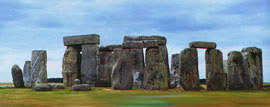Wiltshire's Stonehenge

Stonehenge, Wiltshire United Kingdom (Fg. 3-2)
World famous Sarsen reinforced circle, Stonehenge in Wiltshire United Kingdom, is estimated to have been built first as a primitive structure dating to around 8,000 BCE from remaining Mesolithic post-holes. Archaeological evidence suggests three distinct constructions with three major amendments between 3,100 BCE and 1,600 BCE progressing from timber to stone structures weighing 5 to 40 tons. Speculations ranging from how Stonehenge was constructed, to its specific purpose are still ongoing to present day. Reason for the mystery simply boils down to one amazing fact apart from the megalithic structures, that Stonehenge was built by a culture which did not leave any known written record behind. The only evidence left in the area of those who used the site appears to be found in the form of over 500 barrows, which were mostly bones, suggesting it was largely sacred for the dead. Theories claim the area to have been used for either sacrificial or healing rituals with no other logical explanation for the highly concentrated grave site.
Study over the years has revealed further intriguing findings suggesting that the ancient Sarsen circle, Stonehenge was an ancient astronomical calendar. Alignments between the massive tongue and groove connected stones coincide with the summer and winter solstice, the equinox and certain moon phases. Acoustic research performed here also indicates the mysterious stone circle was formed in a way that emphasizes sound waves while standing inside the area, perhaps to increase rhythmic effects of drums used during rituals. Recent archaeoastronomical theory combines the alignment with supporting bone evidence found at the henge and nearby sites. The results establish that Stonehenge was only used during the winter solstice each year with no clear evidence to place anyone at the site during summer months.
A renowned archaeologist by the name of Mike Parker Pearson discovered a vast settlement outside of the circles, with housing foundations numbering in the thousands, except evidence of the people's core farming practice could not be found. Pearson found massive amounts of food waste around two miles away, at a wooden circle (Durrington Walls) built with the same sophistication and precision as its Sarsen counterpart. He believes the people of Stonehenge traveled from the Stone to Wood circles along the River Avon as part of a ceremonial procession. The curious question we found regarding Pearson's work is, could it be possible the people of Stonehenge instead migrated over the River Avon on a bridge, to another settlement perhaps, and then back up and around to Durrington Walls? Has the area on the other-side of River Avon been surveyed or excavated for clues, maybe forming a triangle between Stonehenge, Durrington Walls, and site X? If this is the case, it may tell us of a much deeper connection to the stars.
† Article 3-2
